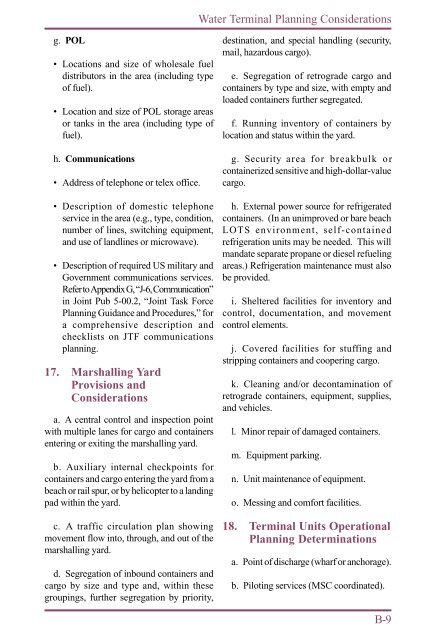JP 4-01.5 JTTP for Water Terminal Operations - BITS
JP 4-01.5 JTTP for Water Terminal Operations - BITS
JP 4-01.5 JTTP for Water Terminal Operations - BITS
Create successful ePaper yourself
Turn your PDF publications into a flip-book with our unique Google optimized e-Paper software.
g. POL<br />
• Locations and size of wholesale fuel<br />
distributors in the area (including type<br />
of fuel).<br />
• Location and size of POL storage areas<br />
or tanks in the area (including type of<br />
fuel).<br />
h. Communications<br />
• Address of telephone or telex office.<br />
• Description of domestic telephone<br />
service in the area (e.g., type, condition,<br />
number of lines, switching equipment,<br />
and use of landlines or microwave).<br />
• Description of required US military and<br />
Government communications services.<br />
Refer to Appendix G, “J-6, Communication”<br />
in Joint Pub 5-00.2, “Joint Task Force<br />
Planning Guidance and Procedures,” <strong>for</strong><br />
a comprehensive description and<br />
checklists on JTF communications<br />
planning.<br />
17. Marshalling Yard<br />
Provisions and<br />
Considerations<br />
a. A central control and inspection point<br />
with multiple lanes <strong>for</strong> cargo and containers<br />
entering or exiting the marshalling yard.<br />
b. Auxiliary internal checkpoints <strong>for</strong><br />
containers and cargo entering the yard from a<br />
beach or rail spur, or by helicopter to a landing<br />
pad within the yard.<br />
c. A traffic circulation plan showing<br />
movement flow into, through, and out of the<br />
marshalling yard.<br />
d. Segregation of inbound containers and<br />
cargo by size and type and, within these<br />
groupings, further segregation by priority,<br />
<strong>Water</strong> <strong>Terminal</strong> Planning Considerations<br />
destination, and special handling (security,<br />
mail, hazardous cargo).<br />
e. Segregation of retrograde cargo and<br />
containers by type and size, with empty and<br />
loaded containers further segregated.<br />
f. Running inventory of containers by<br />
location and status within the yard.<br />
g. Security area <strong>for</strong> breakbulk or<br />
containerized sensitive and high-dollar-value<br />
cargo.<br />
h. External power source <strong>for</strong> refrigerated<br />
containers. (In an unimproved or bare beach<br />
LOTS environment, self-contained<br />
refrigeration units may be needed. This will<br />
mandate separate propane or diesel refueling<br />
areas.) Refrigeration maintenance must also<br />
be provided.<br />
i. Sheltered facilities <strong>for</strong> inventory and<br />
control, documentation, and movement<br />
control elements.<br />
j. Covered facilities <strong>for</strong> stuffing and<br />
stripping containers and coopering cargo.<br />
k. Cleaning and/or decontamination of<br />
retrograde containers, equipment, supplies,<br />
and vehicles.<br />
l. Minor repair of damaged containers.<br />
m. Equipment parking.<br />
n. Unit maintenance of equipment.<br />
o. Messing and com<strong>for</strong>t facilities.<br />
18. <strong>Terminal</strong> Units Operational<br />
Planning Determinations<br />
a. Point of discharge (wharf or anchorage).<br />
b. Piloting services (MSC coordinated).<br />
B-9
















